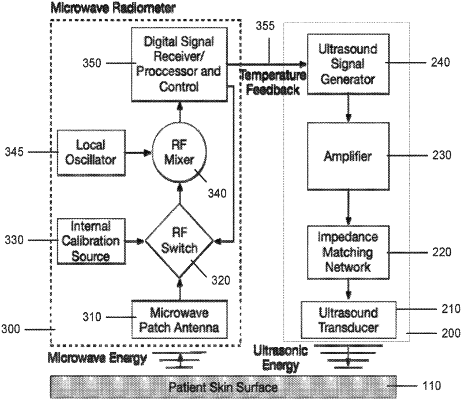| CPC A61N 7/02 (2013.01) [A61B 5/01 (2013.01); A61B 5/0507 (2013.01); A61B 5/4836 (2013.01); A61B 18/04 (2013.01); A61K 41/0052 (2013.01); A61N 1/403 (2013.01); A61N 5/02 (2013.01); A61N 5/022 (2013.01); A61N 5/025 (2013.01); A61B 2018/00791 (2013.01)] | 10 Claims |

|
6. A method of providing ultrasound based heating to produce hyperthermia, the method comprising:
generating, via an ultrasound generator, a low intensity ultrasound signal in a form of an arbitrary ultrasound waveform, the low intensity ultrasound signal inducing hyperthermia in a tissue for a treatment duration, the arbitrary ultrasound waveform having an adjustable amplitude at a predefined frequency in a range of 0.5-5.0 Megahertz (MHz);
amplifying, via an amplifier, the ultrasound signal into an amplified ultrasound signal;
matching, via an impedance matching network, capacitive loads of the amplified ultrasound signal for maximizing power transfer;
producing, via a piezoelectric ultrasound transducer, ultrasonic energy at the predefined frequency and a predefined intensity in a range of 0.1-3.0 Watts per cubic centimeter (W/cm2);
based on the ultrasonic energy, inducing heating of the tissue at a target site to bring the tissue to a predefined temperature, the ultrasonic energy inducing the heating remotely from a source external surface of the piezoelectric ultrasound transducer, a focal distance separating the source external surface and the target site;
focusing the ultrasonic energy, via a water-filled cone, on the target site to heat the tissue;
recirculating and degassing chilled water flowing through the water-filled cone;
passively determining, via a microwave radiometer, temperature of the tissue via received microwaves, the microwave radiometer having a radiometer external surface that is in contact with the target site;
detecting, via a microwave antenna of the microwave radiometer, a microwave signal caused by the ultrasonic energy heating the tissue, the microwave antenna being attached confocally to the piezoelectric ultrasound transducer;
determining, via an internal calibrated temperature source of the microwave radiometer, an absolute temperature;
detecting, based on the microwave signal and via a Radio Frequency (RF) switch of the microwave radiometer, a tissue temperature relative to the absolute temperature;
producing, via a local oscillator of the microwave radiometer, a baseband signal of 1-6 Gigahertz (GHz);
filtering and mixing down, via a RF mixer of the microwave radiometer, background noise in the microwave signal;
integrating, via a digital signal processor of the microwave radiometer, the baseband signal for a period of time to determine a baseband energy of the microwave signal;
determining, via the digital signal processor, an actual temperature by comparing the absolute temperature with the tissue temperature;
feeding back, via the digital signal processor, the actual temperature to the ultrasound generator; and
adjusting, via the digital signal processor, the predefined frequency and the predefined intensity from initial values to adjusted values within a respective ranges.
|